Walking/Working/Standing Surfaces
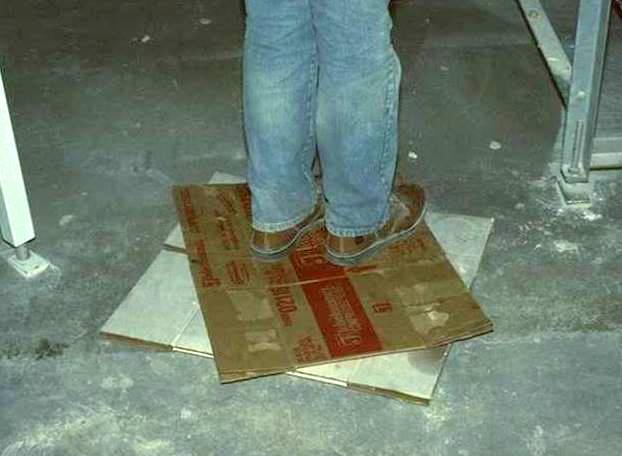 |
| Instinctive use of cardboard to gain cushioning |
Background
The human body does not tolerate standing on hard surfaces well. The most direct effect is pain and discomfort in the heels, known medically as “plantar fasciitis” and more generally as “heel spurs.” Additional consequences include fatigue and strain on back and legs.
Ideally, the surface should be cushioned or made resilient in some manner. Note, however, that this area is not well researched scientifically and guidance is based on common experience, that is, most individuals easily notice the difference between hard surfaces versus standing on anti-fatigue mats or carpeting.
Objectives
Prevent contact stress on heels and feet, i.e. the principle regarding pressure points. Reduce leg and whole body fatigue.
Ideas and Options
Insoles and good footware
 |
|
Regardless of the type of flooring, good footware is essential when standing for long periods. Special shock-absorbing insoles can supplement off-the-shelf footware and can provide great support, especially for supervisors and others who routinely walk on concrete floors where anti-fatigue mats are not feasible.
Vendors for viscoelastic insoles: www.brasco.com, www.viscolas.com
Woodblock
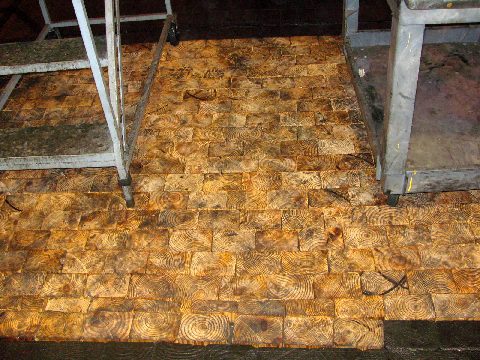 |
| Woodblock flooring |
Wood blocks were for industrial flooring in the beginning of 20th Century. By mid-century, wood was replaced by concrete, which led to increased complaints about heel pain and leg fatigue. Currently, there is some consideration of reverting to wood block because of a number of benefits:
- Ease in removing sections for relocating machinery,
- Less noise generated by moving equipment on the floor
- Less risk of damage to dropped items
- Less wear and tear of moving equipment
- Less discomfort to personnel
- Ease in rolling carts over the surface
Vendors include: www.jennisonwright.com, www.kaswell.com, and www.deltaflooring.com
Although there is anecdotal experience that wood block flooring is easier to stand on than concrete, there is not much quantitative data. Whether woodblock alone (without anti-fatigue mats) is sufficient is unknown.
Wood decking
 |
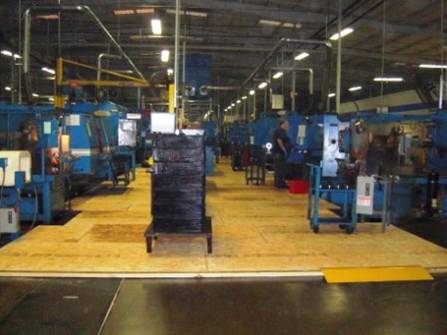 |
| Plywood decking raised 1″ above concrete | Decked machining area |
Wood decking mounted slightly above the floor provides two great advantages: (1) resilience for walking, and (2) ease in rolling carts over the flooring (in contrast to anti-fatigue mats — see below.)
Some machining operations traditionally use decking, since the wood helps prevent slips and falls around oily machines.
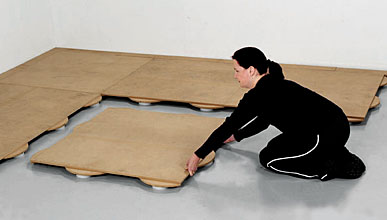 |
| Commercial decking |
Some industrial operations have used “dance floor” or flooring panels originally designed for outdoor events. This type of commercial decking can be remarkably strong, yet resilient for walking.
Grating
 |
 |
| Fiberglass grating in meat processing plant (www.fibergrate.com) | |
Fiberglass grating is often used in meat processing plants or other wet environments as an alternative to anti-fatigue mats. The grating is placed on a frame or on rubber corner mounts (available from grating manufacturers) to raise the grating off the floor at least one-half inch. (Placed directly on the concrete floor usually eliminates the resiliency.)
The grating has the additional advantage of creating a level working surface over concrete that is normally sloped to provide drainage of water. Also, raising the grating off the concrete allows cleaning and sterilization.
Anti-fatigue mats
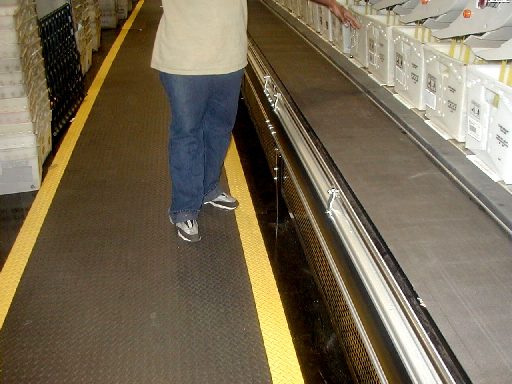 |
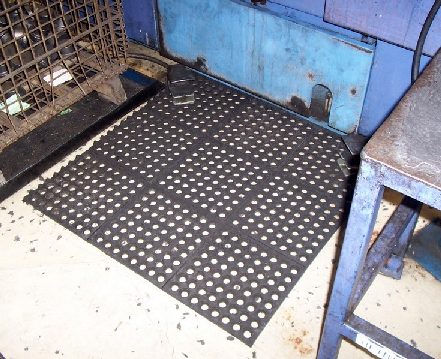 |
| Long runner | Mat with holes for machine coolant |
Anti-fatigue mats are the most common approach to providing cushion when working on hard surfaces. These mats are noticeably easier to stand on than concrete. There are multiple styles, some better suited for certain operations than others. Industrial suppliers usually carry a variety of styles and are knowledgeable about applications.
There are shortcomings to anti-fatigue mats. The primary disadvantage is that the mats are often incompatible with carts and wheeled equipment. The mats can make it difficult to slide chairs in and out to enable alternating between sitting and standing. Some mats are too soft and can create too much friction between foot and mat, causing knee twisting injuries. Finally, the mats themselves become “fatigued” after a while and need to be replaced.
Carpeting
Carpets are normally not used in industrial operations for a variety of reasons. However, it should be noted that carpeting does provide some relief compared to walking on hard concrete. Some styles of carpet may thus be appropriate in some circumstances. Note that carpeting can make pushing wheeled carts more difficult, especially with heavy loads.
Rubber sidewalks
 |
| Rubber sidewalk tiles, made from recycled tires |
An intriguing new possible option for industrial plants is rubber sidewalk, made from recycled tires and waste plastic. As the name implies, this product was designed for sidewalks and playground surfaces, but appears to have the characteristics needed for industrial flooring. These tiles hold the weight of a police car, yet are resilient for walking. (www.rubbersidewalks.com)
(Note. To author’s knowledge, rubber sidewalk has never been used in a workplace to make standing and walking easier. It is listed here as a brainstorming option worth further investigation.)
Comments on lack of scientific studies
Little research has been conducted on the technical issues of walking surface — how soft, how thick, best materials, etc. Most evidence one way or another is based on anecdotal information.
 |
| Marble bouncing off anvil |
The underlying issue may not be “cushioning” per say, but mass or density. The analogy is bouncing a marble off an anvil compared to a wood block. With the anvil, all of the energy is returned to the marble causing it to bounce higher than wood. This is the opposite of what is needed for flooring. As much energy as possible should be absorbed by the flooring, rather than returned back to the human.
Some anecdotal evidence for the density theory includes:
- Wood blocks feel as hard as concrete when rapped with the knuckles, but are different to walk on.
- A hospital experienced a high rate of plantar fasciitis among hospital personnel, most of whom worked on the basement level which had a dense foundation directly under the walking surface.
- Long distance runners prefer earthen paths rather than running on concrete sidewalks and streets.
